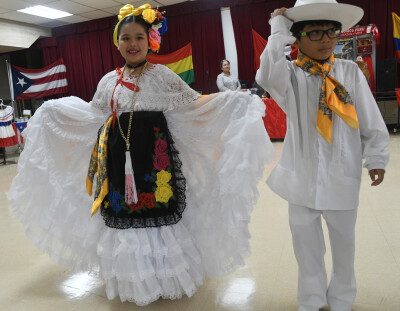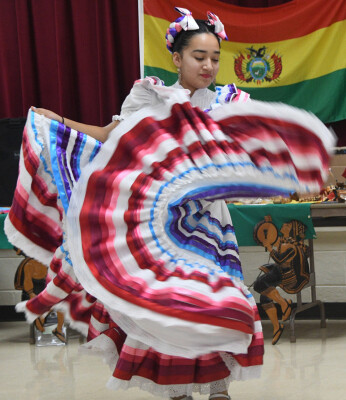For Hispanic and Latino ministries, every month is Hispanic Heritage Month
Despite challenges and changes facing Latino congregations and ministries in the Baltimore-Washington Conference, Sept. 15 through Oct. 15 was a month to celebrate history and heritage.
 While that window of time is nice, truth be told is that Latinos celebrate their culture every month, week and day of the year. The Rev. Cassandra Nuñez, who serves as the pastor at Salem UMC in Baltimore, said it might be a cliché, but it’s the truth.
While that window of time is nice, truth be told is that Latinos celebrate their culture every month, week and day of the year. The Rev. Cassandra Nuñez, who serves as the pastor at Salem UMC in Baltimore, said it might be a cliché, but it’s the truth.
“We do celebrate Hispanic/Latino heritage all year long, all the time,” Nuñez said.
The Rev. Miguel Balderas, who has served in ministry for more than three decades, echoed that sentiment.
“We celebrate no matter anything. No matter all the crises, all the situations, we have time to celebrate,” he said.
That celebration is present in Nuñez’s church ministries and partnerships. When she arrived at Salem, the church’s parsonage was deteriorating, she said. After joining forces with a group, Nuestras Raíces Inc., the church’s parsonage now opens its door every first Friday of the month as a gallery for local Latino artists who might not otherwise have an opportunity to show their talents.
Various types of paintings, sculptures and photographs were on display at the parsonage during Hispanic Heritage Month. The church also partners with a Balet Folklorico dance group to celebrate Latino culture, along with other food and medical distribution organizations.
Hispanic Heritage Month first officially began as Hispanic Heritage Week during President Lydon Johnson’s administration, according to the U.S. Census Bureau. President Ronald Reagan then expanded it to the 30-day period between Sept. 15 and Oct. 15.
 Latino and Hispanic ministries provide an important resource for the community. Those who recently arrived in the United States might be experiencing the isolation of immigrating to a new country, sometimes without documentation.
Latino and Hispanic ministries provide an important resource for the community. Those who recently arrived in the United States might be experiencing the isolation of immigrating to a new country, sometimes without documentation.
“We have left everything behind,” Nuñez, who is undocumented, said. “We feel orphaned, we feel alone in the United States. So to come across a place where I can be part of this family gives us sort of a type of fix to our longing for home, of our homesickness, and that's because of this feeling of belonging to a family of belonging to each other.”
While every ministry regardless of ethnicity has its challenges, Latino ministries face some challenges unique to them.
Some ministries suffer from having mainly undocumented members who regularly move and change congregations in order to find work and other opportunities, Nuñez said. Where another church might have a family move into an area, purchase a home and plan to stay at a church long-term, that doesn’t always translate to Latino ministries.
That regular movement, Nuñez said, makes strengthening connections difficult.
“A lot depends on this desire to survive,” Nuñez said. “If there is no employment, they will move. And if they cannot find a home, they'll have to move and perhaps still try to continue to come to church. But it comes to a point where… church becomes an expense.”
“My struggle perhaps more as a leader is to understand that maybe that is a call in and of itself: to be a master of a community of travelers, of a community of migrants that move,” she added.
According to Balderas, the pastor of Liberty Grove UMC in Burtonsville, more than curating services to Latinos, churches should ebb and flow with their neighborhoods and local changes. In fact, that is what happened with his own congregation.
Balderas’ congregation, like many across the country, saw a decline in membership during the COVID-19 pandemic. Despite the decline, those members still coming into the congregation were extremely diverse across all races and ethnicities.
“It is no more only one culture,” Balderas said. “We need to start doing ministry work with the community because the communities around a regular neighborhood change.”
But demographics in the United States only confirm that churches across the country should prepare to minister to a growing Latino population, if they haven’t already.
Nearly one in five people in the United States identifies as Latino, according to the Pew Research Center. Between 2010 and 2020, Latinos made up more than half of the United States population growth over the decade.
In Maryland, Hispanics make up 8 percent of the population. In West Virginia, they make up 1 percent of the population. In Washington, D.C., Hispanics are 9 percent of the district’s population. Within the BWC, only 691 of the 128,172 United Methodists (or .54 percent) are Hispanic. Thirteen of the BWC’s pastors are Hispanic and the conference has seven congregations that offer Hispanic/Latino worship and ministries.
Balderas said celebrating his and other’s Latino heritage reminds him of the Jewish people in the Old Testament.
“They have a big fiesta, a big celebration with God,” the Rev. Balderas said. “Why? Because God is there. We are doing the same.”
“No matter if sometimes they are [undocumented], they have a problem or they have a crisis, we need to celebrate.”
